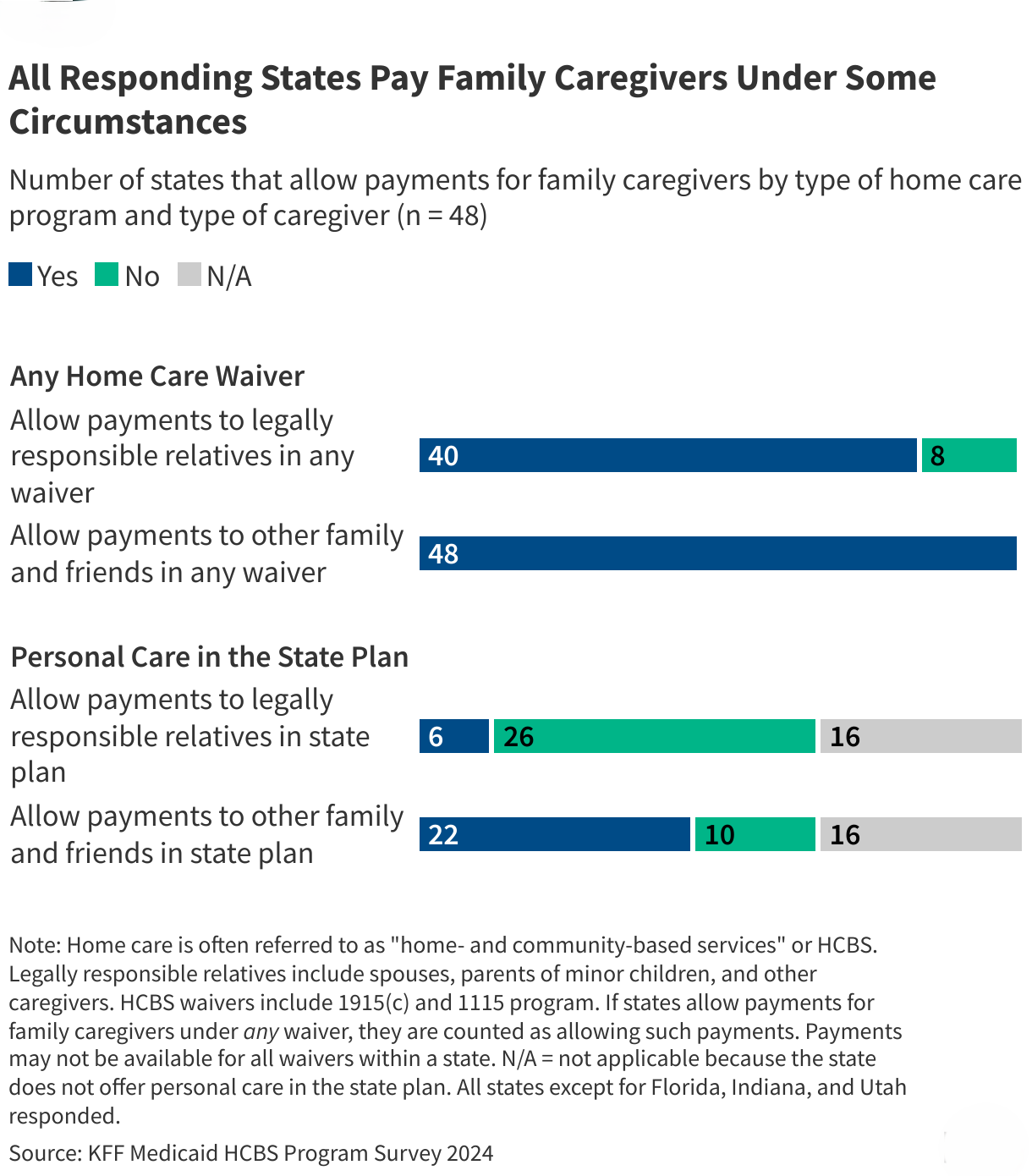KFF estimates that 4.5 million people use Medicaid home care, which provides medical and supportive services to help people with the activities of daily living (such as eating and bathing) and the instrumental activities of daily living (such as preparing meals and managing medications). Medicare generally does not cover home care (also known as home- and community-based services or HCBS), and Medicaid paid for two-thirds of home care spending in the United States in 2022. In Medicaid home care, many people “self-direct” their services, giving them greater autonomy over the types of services provided and who they are provided by; and in some cases, allowing payments to family caregivers. Beyond paying for their caregiving, Medicaid supports family caregivers with services such as training, support groups, and respite care (which is paid care that allows family caregivers to take a break from their normal responsibilities). According to a document made public by Politico, House Republicans are considering reducing Medicaid spending by $2.3 trillion over 10 years, which represents a nearly one-third reduction in Medicaid spending. Cuts of that magnitude would limit states’ ability to continue supporting family caregivers.
This issue brief describes the availability of self-directed services and supports for family caregivers in Medicaid home care. (It is unknown how many people are receiving paid care from family and friends, or how many family caregivers are receiving supports from Medicaid.) The data come from the 22nd KFF survey of officials administering Medicaid home care programs in all 50 states and the District of Columbia, which states completed between April and October 2024. The survey was sent to each state official responsible for overseeing home care benefits (including home health, personal care, and waiver services for specific populations such as people with physical disabilities). All states except Florida, Indiana, and Utah responded to the 2024 survey, but response rates for certain questions were lower. Key findings include:
- All reporting states except Alaska allow Medicaid enrollees to self-direct their home care in at least some circumstances, and among those states all allow enrollees to select, train, and dismiss their caregivers.
- All responding states (which includes the District of Columbia) pay family caregivers under some circumstances and provide family caregivers with other types of support, including respite care (Figure 1, Appendix Table 1)
- Family supports are most widely available for caregivers of people with intellectual or developmental disabilities.
Self-directed services and payments to family caregivers are one of the tools states are using to address shortages of direct care workers, including those who work in home and community settings. Shortages and high turnover rates among the direct care workforce reflect demanding work and low wages. The COVID-19 pandemic escalated an existing workforce challenge for Medicaid home care, and states used new federal funding and flexibility to maintain service levels by increasing self-directed services and payments to family caregivers. Although the pandemic-era flexibilities have ended and the extra funding is winding down, states continue to provide wide-ranging support to family caregivers through Medicaid home care programs.
There is bipartisan support for family caregivers, but funding for programs that support family caregivers is at risk under proposals to cut Medicaid spending by a third. In recent years, there has been bipartisan support for family caregivers, and Congress enacted 2018 law to create a Family Caregiving Advisory Council. The Council’s 2024 report notes that family caregivers are the backbone of the nation’s long-term care system, and that without support, the health, well-being, qualify of life, and finances of family caregivers often suffer. In keeping with bipartisan recognition of the role of family caregivers in the long-term care system, President-elect Trump proposed new supports for family caregivers prior to the election. However, those supports are at risk under Republican proposals to reduce Medicaid spending by $2.3 trillion over 10 years. Over half of Medicaid spending is for the types of Medicaid enrollees most likely to use home care and related services, and major cuts to Medicaid will have implications for their care. States may be forced to reduce spending on Medicaid by eliminating coverage for some people; covering fewer services, and (or) cutting payment rates to providers and supports for family caregivers.
Which states allow Medicaid enrollees to self-direct their home care and for what services?
Nearly all states allow Medicaid enrollees to self-direct their home care in some circumstances (Figure 2, Appendix Table 2). Self-direction came out of the “consumer-directed” movement for personal care services that started with demonstration programs in 19 states funded through grants from the Robert Wood Johnson Foundation. Today, states may give people the option to self-direct home care through a wide variety of optional home care programs. States most frequently allow self-direction in waivers that serve people with intellectual or developmental disabilities, followed by people who are ages 65 and older or have physical disabilities. Among the 48 states responding to KFF’s survey, Alaska is the only reporting state that does not permit self-direction under any of the home care programs.
Among states that authorize self-direction, all states allow enrollees to select, dismiss, and train workers (Figure 3). The ability to select, train, and dismiss workers is referred to as “employer authority” because it allows Medicaid enrollees (with the help of their designated representatives when appropriate) to decide who will be caring for them. All states with self-directed services programs provide employer authority to enrollees. Most states also allow enrollees to establish payment rates for their caregivers (38) and to determine how much Medicaid funding is spent among the various authorized services (36).
Which states pay family caregivers and through which home care programs?
All responding states pay family caregivers through one or more Medicaid home care programs (Figure 1, Appendix Table 1). Payments for family caregivers are generally allowed for the provision of personal care, which may be offered through several different types of Medicaid HCBS programs. Personal care may be provided through waivers such as 1115 or 1915(c) programs, through the Medicaid state plan, or a combination of both. Waiver services tend to encompass a wider range of benefits than the state plan benefit, but waivers are usually restricted to specific groups of Medicaid enrollees based on geographic region, income, or type of disability; and are often only available to a limited number of people, resulting in waiting lists.
All responding states allow payments to family and friends through one or more waiver programs, but fewer states allow payments to legally responsible relatives. Forty states allow payments to legally responsible relatives through waiver programs, and only six states allow payments to legally responsible relatives through the state plan. Payments to other family and friends are also less common through the state plan—allowed by only 22 states. The less common payments to family caregivers through the state plan is because not all states provide personal care through the state plan, and because the legal requirements governing state plan services differ from those governing waiver services.
What are the legal requirements for paying family caregivers?
Medicaid laws have more complicated requirements for states to pay legally responsible relatives than is the case for other types of family and friend caregivers. The specific legal requirements for paying family caregivers are complicated and differ across home care programs:
• For personal care offered through the state plan using section 1905 authority, there is a federal prohibition on paying for services provided by spouses and parents of minor children. Other family and friends may be paid if they meet applicable provider qualifications, there are strict controls on the payments, and the provision of care is justified (which can be done when there is a lack of other qualified providers in the area).
• For home care offered through waiver programs, states may pay legally responsible relatives when the services being provided are “extraordinary care,” which is defined as care that exceeds the range of activities a legally responsible relative would ordinarily perform and is necessary to health, welfare, and avoiding institutionalization. All family and friends who are paid must meet similar requirements as to those governing personal care in the state plan.
• For personal care offered through the state plan using one of the section 1915 authorities, states may pay legally responsible relatives using criteria like those of the waiver programs. Some of those authorities designate a family member as a legal representative and in some cases, family members who are legal representatives may not also be paid caregivers.
Payments for family caregivers are most common under waivers for people with intellectual or developmental disabilities (Figure 4, Appendix Table 3). Among the 45 states that responded to the survey and have waivers for people with intellectual or developmental disabilities, 44 allow payments to family caregivers. There are fewer states with other types of waivers, and the percentage of those states that allow payments to family caregivers is also lower – 39 states for waivers serving adults who are ages 65 and older or have physical disabilities, 17 states for people with traumatic brain or spinal cord injuries, and less states for other types of waivers.
In most cases, family caregivers receive hourly wages like those of other employees, but 10 states have adopted programs known as structured family caregiving, in which family members are paid a per diem rate (Appendix Table 4). Structured family caregiving is a Medicaid benefit that supports unpaid caregivers of people who use Medicaid home care through waiver programs. In the structured program, Medicaid pays provider agencies a daily stipend for participants. The agency is responsible for directing a care coordinator or social worker and a nurse to oversee the family caregiver, answer health-related questions, and provide emotional support; conducting home visits about once per month; and passing a fixed percentage of the stipend (usually 50% – 65%) on to the family caregiver. Among the handful of payment rates reported in an overview of the program by the American Council on Aging, payments to family members are around $40 or $50 per day. States reported structured family caregiving programs in the following waivers:
- Seniors and people with disabilities in 7 states (Connecticut, Georgia, Indiana, Louisiana, North Carolina, North Dakota, and South Dakota),
- People with intellectual and developmental disabilities in 3 states (Indiana, Maryland, and New Mexico),
- Medically fragile children in North Carolina, and
- People with Alzheimer’s and related disorders in Missouri.
What other types of support does Medicaid home care provide for family caregivers?
All responding states provide support for family caregivers—who may be paid or unpaid—and most offer more than one type of support (Figure 5, Appendix Table 5). The most commonly covered benefit was respite care (offered by 47 states—all responding states except for Oregon), which provides short-term relief for caregivers, allowing them to rest, travel, attend appointments, or spend time with other family and friends. Other commonly covered benefits include caregiver training (33 states), and counseling or support groups (23 states).
Respite care may be provided anywhere from a few hours to several weeks at a time. Medicare only covers respite care for people who are receiving hospice care, which is only available for people who are terminally ill and electing to receive comfort care instead of curative care for their illness. That makes Medicaid’s respite care the primary source of coverage for caregivers of people with Medicare and Medicaid. Respite care is offered most frequently under waivers for people with intellectual or developmental disabilities (42 states) and seniors and people with disabilities (38 states).
Daily respite care is offered by the most states (40), followed by institutional respite care (offered by 35), but different types of waivers tend to rely more heavily on different types of respite care (Figure 6, Appendix Table 6). Daily respite care is available under waivers for people with intellectual and developmental disabilities in 31 states but only available in 26 states within waivers for people who are ages 65 and older or have physical disabilities. Alternatively, 26 states provide institutional respite care within waivers for people who are ages 65 and older or have physical disabilities but only 19 states do so within waivers for people with intellectual and developmental disabilities. Weekly respite care is the least frequently offered, and over half of states (30) report offering other types such as hourly, monthly, or annual. Some states reported covering respite care through adult day centers or overnight camps.
This work was supported in part by Arnold Ventures. KFF maintains full editorial control over all of its policy analysis, polling, and journalism activities.
Publisher: Source link









